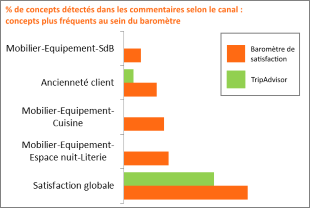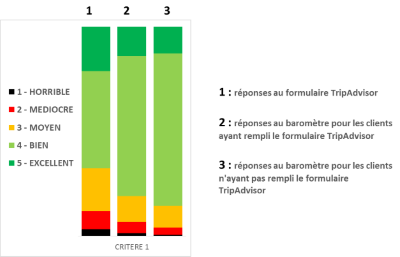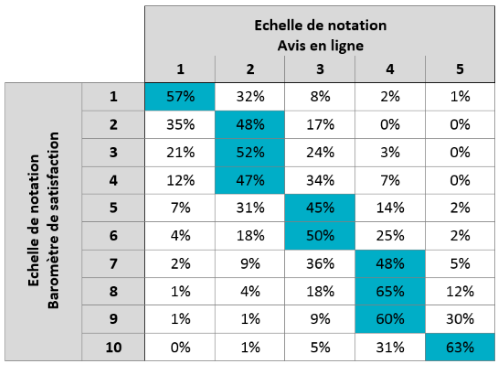wednesday, october 15, 2014
Satisfaction survey & online reviews: additional insights
Websites specializing in online reviews, social networks, satisfaction barometers, complaints... your customers have more and more channels at their disposal for expressing their delight or dissatisfaction with their experience.
Taken individually, these means of communication seem to differ in content, both in tone and in the themes they address.
We wanted to take a closer look at the differences between the results of a satisfaction survey and evaluations on an online review site.
One of our customers, a player in the tourism sector, is offering its own customers the opportunity to respond to the satisfaction barometer and submit an online review. The barometer collects feedback for the company, while the online review is public feedback for the web community. Thanks to this mechanism, customers are solicited only once and can address different contacts. In this way, our customer gives its own customers the opportunity to address web users (other potential customers) without the former necessarily having had the idea in the first place.
Technically, the company sends its customers an email inviting them to take part in the satisfaction survey. At the end of the survey, the TripAdvisor form is displayed. The respondent chooses whether or not to leave a review.
This mechanism has a dual effect:
- less solicitation of customers
- improve the visibility of our establishments on the Internet
The study therefore consists of comparing comments and ratings on the two communication channels (satisfaction barometer and TripAdvisor). We have drawn three main qualitative and quantitative conclusions from this analysis.
Lessons learned
- The tone
The comments recorded in the barometer are relatively more critical than reviews posted on TripAdvisor - the barometer records 10% fewer positive concepts than online reviews. Customers express themselves more harshly when addressing the company, the aim being to highlight areas for improvement, whereas public reviews are closer to more nuanced advice.
- The themes
In the case of tourist stays, the message sent to the company focuses on the accommodation, its cleanliness, comfort and furnishings.
At the same time, public feedback focuses on the environment (surroundings, access, buildings, etc.).
In this way, the customer targets his message according to the entity he is addressing: technical aspects will be addressed for feedback to the company, feedback on which it can act directly, while aspects of perception and feeling will be favored for advice to other Internet users.


These graphs validate the fact that the messages are complementary: for the company, the comments target aspects on which the company can take action, while for Internet users, the opinion expresses the setting, the feeling.
Furniture-related concepts are mentioned in the barometer comments, but not in the online reviews. Conversely, themes such as proximity to shops and leisure facilities, or the environment of the accommodation, are more present on TripAdvisor.
- Scoring
The distribution of the TripAdvisor form gives establishments greater visibility on the web. But it doesn't stop there. As noted in the article "What does the future hold for satisfaction surveys?giving feedback on a dedicated site after an experience requires a certain level of motivation on the part of the customer. Giving customers the option of simply posting their review helps to diversify ratings and avoid the domination of extreme ratings (those more inclined to give their opinion spontaneously - and therefore over-represented on the web).
Nevertheless, the distribution of TripAdvisor ratings shows that the customers who express themselves there represent the extremes (delighted or very dissatisfied customers). According to the criteria studied, the so-called soft underbelly is slightly under-represented.
Rating of criterion 1 by channel

For each criterion, we compare 1) the distribution of scores under TripAdvisor, 2) the distribution of scores in the barometer specifically for respondents who subsequently completed the TripAdvisor form, 3) the distribution of scores in the barometer for respondents who did not complete the proposed TripAdvisor form.
This graph illustrates that the ranking of satisfactory or unsatisfactory criteria remains equivalent from one population to another, but also that reviews are less moderate on online review sites (overrepresentation of HORRIBLE/MEDIOCRE and EXCELLENT classes).
In conclusion
The message conveyed by respondents can be adapted to suit the target audience. For example, in a satisfaction survey, they may try to suggest technical improvements to the company, while on a specialized website, they may offer advice.
Let's not forget, however, that the wording of the questions differs from one channel to another. While the survey asks for "suggestions" or "comments", TripAdvisor asks for the consumer's "opinion". This specification must be taken into account when analyzing the results, as must the rating scales (see footnote on equivalences).
A few methodological guidelines
- Perimeter
Verbatim analysis is carried out on a population of 546 respondents whose stay dates back to February 2014.
The notes analysis takes into account visits over the year 2014 (January - September).
- Reading verbatims
Semantic analysis enables us to classify customer comments 1) by tone, 2) by concepts defined prior to the survey. We applied the same algorithm to TripAdvisor reviews as that used for the satisfaction barometer.
- Reading notes
The criteria evaluated and the rating scale differ from the TripAdvisor satisfaction barometer and form. Satisfaction ranges from 1 to 10 in the satisfaction survey vs. a rating of 1 to 5 for TripAdvisor. The correspondence table opposite shows us that ratings can still be matched from one channel to another.
Correspondence between satisfaction barometer and TripAdvisor scores

The percentage can be read online: 57% of respondents who gave a score of 1 to the barometer question also gave a score of 1 to the TripAdvisor question. The barometer scores have therefore been recoded according to the cells highlighted in blue.